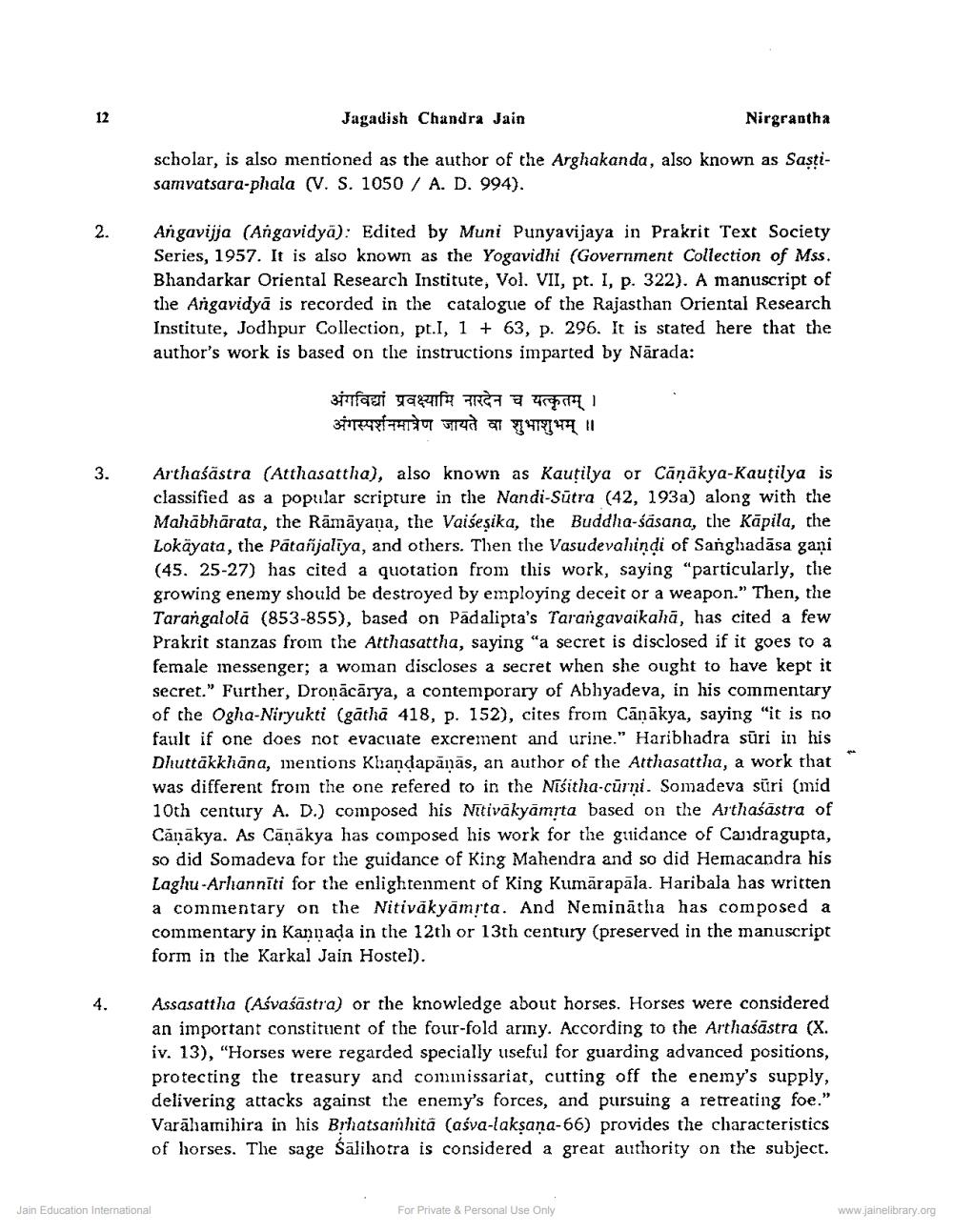Book Title: Some Prakrit Works on Non Religious Literature Author(s): Jagdishchandra Jain Publisher: Z_Nirgrantha_1_022701.pdf and Nirgrantha_2_022702.pdf and Nirgrantha_3_022703.pdf View full book textPage 2
________________ Jagadish Chandra Jain Nirgrantha scholar, is also mentioned as the author of the Arghakanda, also known as Sastisamvatsara-phala (V. S. 1050 / A. D. 994). Angavijja (Angavidya): Edited by Muni Punyavijaya in Prakrit Text Society Series, 1957. It is also known as the Yogavidhi (Government Collection of Mss. Bhandarkar Oriental Research Institute, Vol. VII, pt. I, p. 322). A manuscript of the Angavidyā is recorded in the catalogue of the Rajasthan Oriental Research Institute, Jodhpur Collection, pt.I, 1 + 63, p. 296. It is stated here that the author's work is based on the instructions imparted by Närada: अंगविद्यां प्रवक्ष्यामि नारदेन च यत्कृतम् । अंगस्पर्शनमात्रेण जायते वा शुभाशुभम् ॥ Arthaśāstra (Atthasattha), also known as Kautilya or Cānäkya-Kautilya is classified as a popular scripture in the Nandi-Sūtra (42, 193a) along with the Mahābhārata, the Rāmāyana, the Vaišeşika, the Buddha-sasana, the Kapila, the Lokäyata, the Patanjaliya, and others. Then the Vasudevahindi of Sanghadāsa gani (45. 25-27) has cited a quotation from this work, saying "particularly, the growing enemy should be destroyed by employing deceit or a weapon." Then, the Tarangalola (853-855), based on Pädalipra's Tarangavaikahā, has cited a few Prakrit stanzas from the Atthasattha, saying "a secret is disclosed if it goes to a female messenger; a woman discloses a secret when she ought to have kept it secret." Further, Dronācārya, a contemporary of Abhyadeva, in his commentary of the Ogha-Niryukti (gāthā 418, p. 152), cites from Cānākya, saying "it is no fault if one does not evacuate excrement and urine." Haribhadra sūri in his Dhuttākkhāna, mentions Khandapānās, an author of the Atthasattha, a work that was different from the one refered to in the Niśitha-cūrni. Somadeva sūri (mid 10th century A. D.) composed his Nītivākyämta based on the Arthaśāstra of Cănākya. As Canākya has composed his work for the guidance of Candragupta, so did Somadeva for the guidance of King Mahendra and so did Hemacandra his Laghu-Arhanniti for the enlightenment of King Kumārapāla. Haribala has written a commentary on the Nitivăkyāmrta. And Neminātha has composed a commentary in Kannada in the 12th or 13th century (preserved in the manuscript form in the Karkal Jain Hostel). Assasattha (Ašvaśāstra) or the knowledge about horses. Horses were considered an important constituent of the four-fold army. According to the Arthaśāstra (X. iv. 13), "Horses were regarded specially useful for guarding advanced positions, protecting the treasury and commissariat, cutting off the enemy's supply, delivering attacks against the enemy's forces, and pursuing a retreating foe." Varāhamihira in his Brhatsamhita (aśva-laksaņa-66) provides the characteristics of horses. The sage Salihotra is considered a great authority on the subject. Jain Education International For Private & Personal Use Only www.jainelibrary.orgPage Navigation
1 2 3 4 5 6 7 8 9 10
